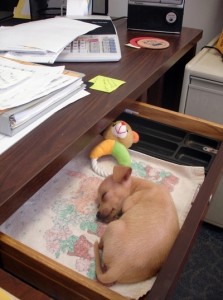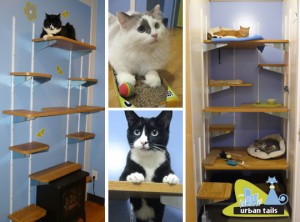Archive for June, 2012
Taking your dog to work. Will you be less stressed out?
 Some companies allow employees to take their dogs to work . Virginia Commonwealth researchers did an interesting study. A company with about 55o employees were allowed to bring their dogs with them to work. About 20 to 30 dogs came to work with their owners each day. Pets were allowed in this company’s office for about 15 years. The dogs lie quietly at their owners’ feet — in the call center, at reception, in the corporate offices and even in a repair area where workers handle fragile crystal and china. Even the company’s chief executive has been known to bring his miniature dachshunds to work. The researchers took 76 employees and divided them into three groups. Those who brought their dogs to work, those who owned dogs but left them at home and those who didn’t have pets. For one week, the researchers measured the levels of the stress hormone cortisol in samples of the workers saliva. They used surveys to gauge stress levels four times each day.
Some companies allow employees to take their dogs to work . Virginia Commonwealth researchers did an interesting study. A company with about 55o employees were allowed to bring their dogs with them to work. About 20 to 30 dogs came to work with their owners each day. Pets were allowed in this company’s office for about 15 years. The dogs lie quietly at their owners’ feet — in the call center, at reception, in the corporate offices and even in a repair area where workers handle fragile crystal and china. Even the company’s chief executive has been known to bring his miniature dachshunds to work. The researchers took 76 employees and divided them into three groups. Those who brought their dogs to work, those who owned dogs but left them at home and those who didn’t have pets. For one week, the researchers measured the levels of the stress hormone cortisol in samples of the workers saliva. They used surveys to gauge stress levels four times each day.
There was no significant difference in cortisol levels among the participants but by the end of the day, the average stress level scores fell about 11% for the employees who brought their dogs to work while the stress levels rose more that 70% for the employees that did not take their dogs to work. During the day, people who hadn’t brought pets walked over to colleagues who had and asked whether they could take the visiting dogs for walks.
In addition to all of the love they provide, our pets reduce our stress levels.
Remember, your pets count!
Boarding your cat
 Vacation time is here and we’re now faced with whether or not to board our cats while we’re gone. If you are going away for more than two days and don’t have a neighbor or friend to take care of them, I would then recommend that you board them. Here are some tips. It’s very important that you do your research.
Vacation time is here and we’re now faced with whether or not to board our cats while we’re gone. If you are going away for more than two days and don’t have a neighbor or friend to take care of them, I would then recommend that you board them. Here are some tips. It’s very important that you do your research.
Price – Make sure that you find a place that you can afford. Call or visit the facility. Check prices online. Make sure that there are no hidden fees and see if you can get a discount for boarding more than one cat.
Security – It’s important that you cat is comfortable, safe and secure while you’re gone. Make sure that the facility is safe. I would rather board by cats in a busy, well lit area.
Staff – Visit the staff before you take your pet. Make sure that the staff is professional, friendly and willing to answer all of your questions. Check to see if the facility is staffed 24 hours a day. This is the type of place that I would choose. See if it’s also open to the public during this time.
Ventilation – check to see if the facility also boards dogs. If so, ask if there is a separate ventilation system for cats. Your cat will be nervous as it is and smelling a bunch of strange dogs will really agitate her.
Food – I would bring the food to the facility. Make sure that the staff is willing to feed your cat the food that you bring, this way your cat don’t have to get used to different food. You can feel more secure that your cat is eating the food that she is used to everyday.
Veterinarian – Bring your cats medical records and make sure that there is a veterinarian on duty or the facility is located close to a clinic.
Now you can feel better about leaving your cat and can enjoy your vacation!
Remember, your pets count!
Rules for preventing aggression in puppies
 Puppies need to be at the bottom of the pecking order in a household. Puppies that are aggressive become calmer when they realize that they are the lowest ranking member of the family. The first step that you must take goes back before you take your puppy home. Be sure that the breed and individual puppy that you choose is right for your family. If possible, sit alone in a room with the entire litter. You’ll notice that the more dominant puppies will take charge while playing. They’ll also seek out strangers in the room. The more fearful ones will sit by themselves in the corner looking frightened or sad. If you want a well behaved puppy, don’t choose the most dominant or the most fearful puppy. Breeds such as Rottweilers, German Shepherds, Akitas and pit bulls are not good breeds for timid owners. Lap dogs are great pets but they don’t like loud, rowdy children.
Puppies need to be at the bottom of the pecking order in a household. Puppies that are aggressive become calmer when they realize that they are the lowest ranking member of the family. The first step that you must take goes back before you take your puppy home. Be sure that the breed and individual puppy that you choose is right for your family. If possible, sit alone in a room with the entire litter. You’ll notice that the more dominant puppies will take charge while playing. They’ll also seek out strangers in the room. The more fearful ones will sit by themselves in the corner looking frightened or sad. If you want a well behaved puppy, don’t choose the most dominant or the most fearful puppy. Breeds such as Rottweilers, German Shepherds, Akitas and pit bulls are not good breeds for timid owners. Lap dogs are great pets but they don’t like loud, rowdy children.
All puppies need to be handled frequently, gently and firmly between the ages of six and eighteen weeks. They should be hand fed by everyone in the family and they must learn to accept food in a gentle manner. They should be verbally scolded and affection withheld if they jump, on people, growl or ride legs. Aggression prone dogs should not be wrestled with or engaged in a tug of war. They should only be verbally reprimanded with a firm “no” then denied them affection for ten minutes. You can reward them with a treat when they begin to understand the rules.
Puppies can learn good behavior from other dogs. It’s always good to expose them to well trained, people friendly and non aggressive dogs as playmates. The good behavior will rub off pretty quickly on a pet who is misbehaving.
Remember, your pets count!